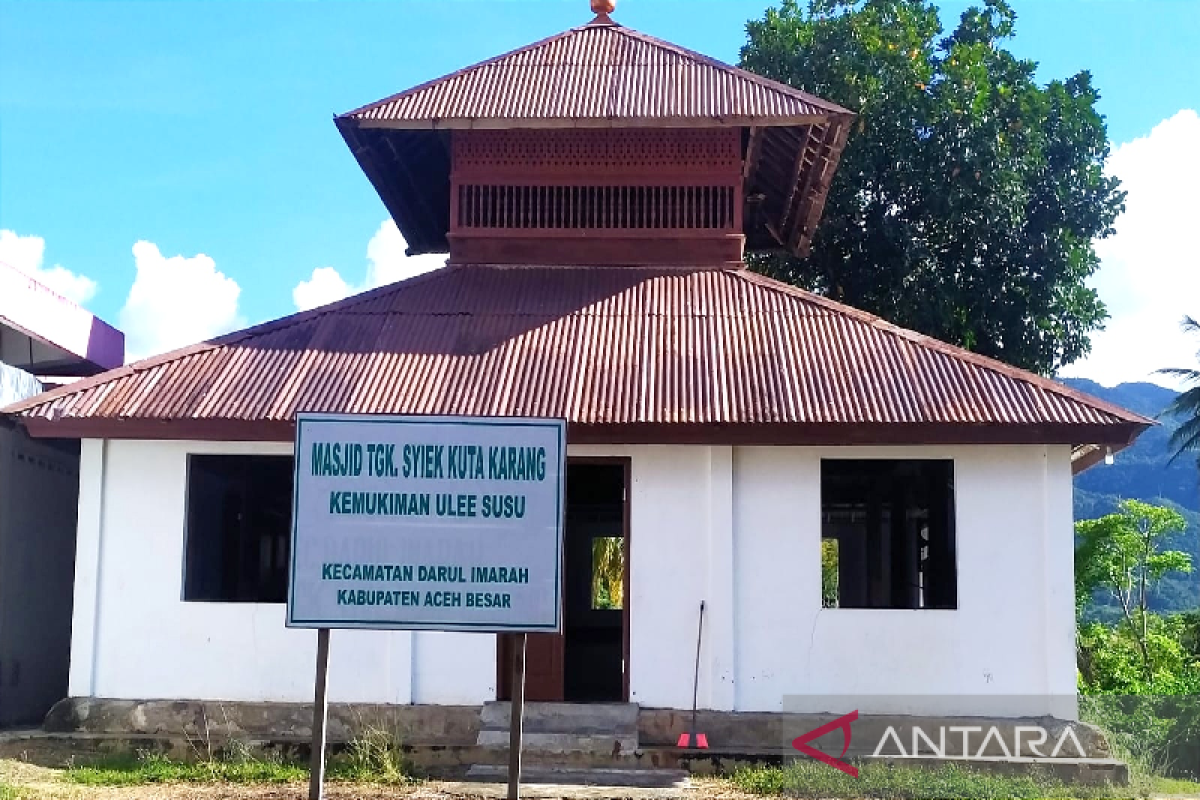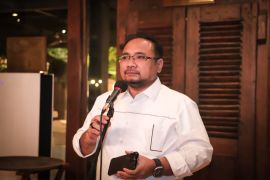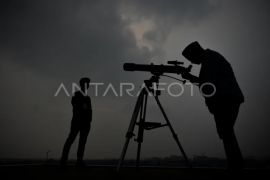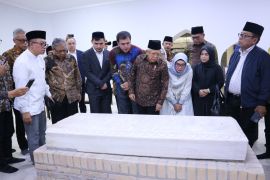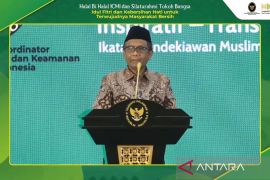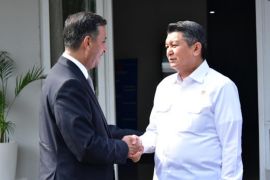This mosque is sometimes visited by tourists. Some local tourists had visited this mosque, but Malaysian tourists are the ones who are more frequent in visiting this mosqueBanda Aceh, Aceh (ANTARA) - Nestled between rice fields in Kuta Karang Village, Darul Imarah Sub-district, Aceh Besar District, Aceh, is a large white mosque adorned with two domes atop it.
Shortly, residents start emerging from the mosque after performing their congregational Ashar afternoon prayer. Coconut trees beside the mosque provide shade to them.
If one passes through the large white mosque building, one will then come across a smaller, humbler building beside the mosque.
Turns out, the smaller building is also a mosque, as indicated by the sign in front of it that identifies the mosque’s name as Masjid Teungku Syiek Kuta Karang.
A gentleman then approached the mosque sign, and he greets “Assalamualaikum” (peace be upon you) to the passing people. He is Ikhwani, a local resident that helps tend to the mosque.
Ikhwani then revealed that the smaller mosque has a long-standing history, a fact which motivates him to help manage the old building daily.
“This mosque was constructed in 1860, some 13 years before the arrival of the Dutch to Aceh. The Dutch first entered Aceh in 1873,” the resident revealed.
Since being constructed by local cleric Teungku Syiek Kuta Karang, due to which the mosque got its name, the mosque was renovated only twice: in 1951 and in November 2018.
The renovation works include replacing the mosque wall from wood to mason, replacing the mosque flooring with ceramic, and raising the mosque’s floor slightly. The mihrab, where the Imam, who leads congregational prayers, stands was made permanent by applying cement.
Despite the renovation, the mosque’s form and size remain unchanged. Some original features of the mosque, such as the original wooden pillars inside the mosque and the mosque roof, are still preserved.
Related news: Tourism Ministry opens Ramadhan Fest 2022 for MSMEs
“The last renovation was conducted in November 2018. Some of the wooden pillars are preserved because they can still be used,” Ikhwani remarked.
He stated that during the Aceh War, the mosque was among the only seven mosques that were left unscathed by the Dutch, who razed other mosques in the region. The renowned Baiturrahman Grand Mosque in Banda Aceh was not spared by the Dutch at that time, he added.
Currently, the older mosque is no longer used for daily prayers, as the newer mosque located in proximity could accommodate the congregation better.
The mosque is currently used for daily evening Quran recitals and becomes a classroom for local children studying the Quran. In the past, the Teungku also used the mosque as a place to provide treatment to ill residents, Ikhwani remarked.
“Nowadays, residents, who paid a visit, will sometimes pray once here. The old mosque is also the classroom for children, who are learning the Quran,” he noted.
The life of Teungku Syiek Kuta Karang
Syekh Abbas bin Muhammad al-Asyi, nicknamed Teungku Syiek Kuta Karang, was a cleric, astronomer, physician, and anti-Dutch fighter.
The Teungku is not only remembered by the local Acehnese but also by Malaysians that know him, as most of his works are preserved there.
Despite his expertise in Islam and other forms of knowledge, his date and place of birth are unknown; and this remains a huge question mark for the Acehnese even until now. Even without his birth data, it was certain that Teungku Syiek Kuta Karang was a native of Aceh, Ikhwani remarked.
Teungku Syiek Kuta Karang died in November 1895 and was buried at the Teungku Abdullah Kan’an cemetery in Leugeu Village, Darul Imarah Sub-district, Aceh Besar District. He was privileged to be buried close to Abdullah Kan’an since during his lifetime, he was the one who maintained the cemetery, Ikhwani noted.
The cleric was also an advisor to the Aceh Sultanate royals, who sought his advice in legal affairs and during the decision-making process, he remarked.
Due to his position among the Aceh royals, Dutch orientalist Christiaan Snouck Hurgronje even commented on him. Hurgronje described Teungku Syiek Kuta Karang as being an active, clever, yet weird cleric.
Related news: Avoid using motorcycles for homecoming travel, ministry advises people
According to Hurgronje, Teungku was outspoken about his opinion that he would disseminate while teaching at his school, in the articles he wrote, or in the sermons he delivered. His role was even more important during the Aceh struggle against the Dutch, Ikhwani noted.
“In books that I have read, Hurgronje concluded that Teungku Syiek Kuta Karang is weird because of his staunch opposition against the Dutch,” he noted.
Ikhwani expounded that Teungku Syiek Kuta Karang left many works in history, religion, and medical knowledge. The cleric, throughout his life, had written five books, he stated.
“He had written five books throughout his life, yet most of his works are now preserved in Malaysia. I have this book (about Teungku) after I ordered it from a Malaysian bookstore,” Ikhwani stated.
Foreign tourists visit the old mosque
In comparison with the popular Baiturrahman Grand Mosque in Banda Aceh that has attracted domestic and foreign tourists keen to experience the mosque’s grandeur, Teungku Syiek Kuta Karang Mosque is not much popular.
Despite the mosque not been developed as a tourist attraction, domestic and foreign tourists, especially from Malaysia, are oftentimes spotted at the Teungku Syiek Kuta Karang Mosque.
“This mosque is sometimes visited by tourists. Some local tourists had visited this mosque, but Malaysian tourists are the ones who are more frequent in visiting this mosque,” Ulee Susu region head Muhammad Yusuf stated.
He revealed that a family from Malaysia had consistently visited the mosque every year and had been keen to express their gratitude to Teungku Syiek Kuta Karang from whom they had gained medical knowledge by providing routine donations to the mosque.
The Malaysian tourists often pray at the old mosque instead of the newer building, the village head remarked, adding that they always visited Teungku Syiek Kuta Karang’s cemetery after praying at the mosque.
Donations provided by them are sufficient to fund the renovation of the cemetery, Yusuf stated.
Related news: Jakarta to hold religious walking tour to celebrate Ramadan
“The cemetery's beautification is also funded by Malaysian tourists. They are very attentive (to the conditions here),” he remarked.
Yusuf noted that despite its historical value, the Teungku Syiek Kuta Karang mosque is yet to be declared as a heritage site, so it receives no funding from the district authority. He added that the local community had fought for heritage status for the mosque in the last two years to which the district authority had yet to respond.
Teungku Syiek Kuta Karang mosque must be preserved, as it is testament to Teungku's role in the history of Aceh's people. His life and works are also a common history that Indonesians and Malaysians both share until now.
Related news: Manpower Minister distributes basic needs packages in Jakarta, Bekasi
Related news: Nuzulul Quran momentum to strengthen togetherness: President
Editor: Fardah Assegaf
Copyright © ANTARA 2022
